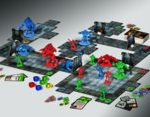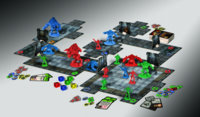One Story, Many Media

Kevin Wilson describes his methodology of boiling a franchise down to its core elements and weighing the differences among media when translating games from medium to medium.
Thanks to modern licensing practices, it’s not unusual to see one Intellectual Property (IP) translated into many different forms. Such conversions can prove extremely challenging, but they’re also a good way to identify an IP’s core “value proposition” - that is, the essential set of traits that allow the consumer to recognize the IP as being unique and valuable. It’s also a good way to examine differences in storytelling across different media. During the last several years, I’ve created licensed board games from such diverse game media as video games (Warcraft and Doom) and pen-and-paper role-playing games (Call of Cthulhu). Each such conversion brings its own challenges, but at the core is a single task: How can I retell a story designed for an entirely different medium in a way that acknowledges the strengths and weaknesses of the medium I’m working in?
Perhaps the best illustration of this was the Doom 3 conversion from video game to board game. In its original form, Doom relied on state-of-the-art rendered 3D graphics, a carefully orchestrated soundtrack, and hundreds of lighting and animation effects to deliver its story. Additionally, the play experience was one of total adrenaline and instant gratification, featuring online death matches and a dedicated modding community eager to use the graphics engine to create their own works of art. In fact, Doom effectively created the first-person shooter death match community when it first brought office LANs around the world to a standstill after its release.
However, it didn’t seem like it was enough to simply simulate the video game in board game form. Doing that would deliver nothing new and exciting to the fan base and, worse, would ignore the strengths and weaknesses of the board game medium - effectively, the story would suffer. Struggling with the issue for a while, it was easiest to finally make a shopping list comparing video games to board games:
Video Games
Good at real-rime
Orchestrated soundtrack
Instant gratification
Lack of human interaction
2D (visual elements only)
Board Games
Poor at real-rime
Sound effects difficult and expensive
Slower playing experience
Face-to-face (very social)
3D (tactile elements)
A list of the core elements of Doom was also created:
Core Elements
Doom weapons (Shotgun, BFG, Chainsaw, etc.)
Doom monsters (Imps, Mancubi, Pinky Demons, etc.)
Marines
Mars base
Moving through corridors
Opening doors
Color-Coded keycards
Triggered events
Different levels
With these lists, I was able to focus in on the things that board games were good and bad at, and the things I needed to retain the Doom “identity.” Obviously the board game wasn’t going to be able to rely on any sort of animated graphics or sound. Additionally, there was no way to capture the freewheeling adrenaline blast of the computer game - board games simply played too slowly for that. However, board games had their strengths. They were face-to-face, so the player communication issues that haunt video games even after the creation of such programs as Teamspeak were negligible. Better yet, they could use tactile elements, engaging a player’s sense of touch in a way that video games couldn’t. Armed with this information, it was much easier to determine what features to focus on and emphasize in the design.
First, it was determined that gameplay would be kept simple and fast, to get as close to simulating the speed of the video game as possible. A player’s turn consisted of choosing one of four actions and carrying it out, while attacks were distilled to a single die roll that determined both range and damage. Large sculpted plastic miniatures would take advantage of the tactile strengths of the medium, and it was decided to pit a team of marines against a single monster player in order to maximize the social elements of the game. Finally, randomized special abilities were added to the marines to pigeonhole them into specific roles and enhance the need for teamwork. The story arc was effectively changed from a solitary marine facing hordes of monsters to a team of marines working together against an unseen menace controlling dozens of monsters. The monster player could threaten and bluster, while the marine players would need to discuss strategies in order to act as a team.
Once this was accomplished, it was a simple matter to import the core concepts of Doom - creating weapons and monsters using the attack dice system, and building changeable boards out of cardboard. A series of scenarios, or levels, were created for the marines to fight their way through, and triggered events were added both in the scenarios and in the form of event cards to keep things surprising even after the players had played through a level previously. In addition, the triggered events could allow me to tell stories through the board game that I wouldn’t have previously thought possible. With them, I could create more effective foreshadowing, branching plotlines, and even more complicated player decision trees. I was also able to follow the storyline of the video game, but keep it different enough to surprise hardcore fans.
In the end, the finished result had some very distinct differences from its video game roots, but it still retained the “feel” of Doom, because the core elements were retained and adapted to the new medium. Better still, it delivered a play experience that was unique and different from the video game, allowing fans to experience one of their favorite stories in a whole new way, and so I consider the design an artistic success.
The original board game Arkham Horror was designed by Richard Launius and published by Chaosium in 1984. In the two decades since the game’s original publication, the hobby game market (and board game design philosophies) have changed drastically, so when Fantasy Flight Games acquired the license to republish Arkham Horror, a thorough overhaul of the game was necessary. Beyond simply commissioning new art and designing more modern-seeming game components, I fundamentally altered some of the core rules mechanics (e.g., instead of rolling dice for movement, each Player Character now has a “Speed” score that determines how far he or she can move).
This redesign was challenging, to be sure, but it also offered some exciting opportunities for storytelling, particularly because it allowed me to draw more deeply on some of the storytelling elements of the Call of Cthulhu role-playing game (the inspiration for Richard’s original design). For example, I replaced the charts and tables in the original game with location-specific decks of cards, which are drawn from when a player moves to that location. Typically, these are short, self-contained encounters that tell a brief story. However, by carefully crafting these encounters for each location, it is possible to give each place a certain feel, with recurring characters and themes.
I also experimented with creating actual story arcs via the location decks. In one instance, a kindly old man named Harney Jones helps out the player during most of the encounters at a certain location. However, one encounter results in the death of the old man and the closure of that location for the rest of the game. Due to the random nature of the location decks, it’s possible for the old man to die immediately the first time a player enters that location. However, with repeated plays, the players learn and remember the story as I intended it, because even if it doesn’t work out every time, more often than not it occurs in the order I intended. The players meet kindly old Harney Jones, he helps them out somehow, and then later they find that he has passed away while sitting in the rocking chair on his porch. It’s not a complex story, but it’s certainly more involved than players expect from a board game.
Another location features the possibility of accepting a deal from a dark stranger to gain some beneficial items now for an unspecified cost later. All that the player is told is that he should “remember that you have make a deal with the dark man of Wizard’s Hill.” He has to take the cost on faith unless he’s played the game enough to learn what it is beforehand. There is a random event deck that is drawn from every turn, and in that deck is a single card that calls the debt due by killing every character that made a deal with the dark man and quite possibly costing the players the game. On the one hand, the card could never come up, and the player would receive a powerful reward for free. On the other hand, if the card does show up, it has a good chance of costing the players the game. In this way, I was able to create a story that feels dangerous and tense for the player who chooses to take a gamble and accept the deal.
The funny thing is, I only stumbled across these methods of storytelling for board games because I was attempting to convert a role-playing game into one. Without the outside stimulus of the role-playing game, I wouldn’t have noticed that it’s possible to create fairly complex and interesting stories in the form of a board game. Similarly, the triggered events in Doom only came about because of similar triggered events that I’ve seen and programmed into video games, effectively an IF…THEN tree. So, I’ve found that by respecting a medium’s strengths and weaknesses, but at the same time looking to see what storytelling techniques other media have to offer, I’ve been able to bring some genuinely new things to the world of board gaming.
References
Arkham Horror. Richard Launius and Kevin Wilson; Fantasy Flight Games. 2005.
Doom: The Board Game. Kevin Wilson; Fantasy Flight Games. 2004.
Cite this article
Wilson, Kevin. "One Story, Many Media" Electronic Book Review, 27 January 2008, https://electronicbookreview.com/publications/one-story-many-media/
